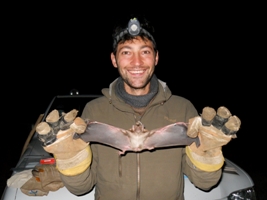The Streicker Group
Research Overview
We investigate pathogen transmission between species. We aim to identify fundamental ecological and evolutionary processes that govern disease transmission in natural systems and use this information to fuel evidence-based actions to prevent and control diseases with real-world importance.
Most viruses infect multiple host species and ‘zoonotic’ transmission (from animals to people) is the most frequent source of newly emerging human diseases. Impacts of most zoonoses are currently mitigated by treating “spillover hosts” (humans and domestic animals) after viruses emerge. However, this approach indefinitely prolongs the risk of spillover and epidemic spread, allowing enormous health and economic costs to accumulate. The COVID-19 pandemic provides a stark example of the potential costs of this reactive approach to zoonosis control. Developing approaches to control zoonotic viruses within their wildlife reservoirs or to anticipate their emergence would improve prospects to reduce or in some cases eliminate the burden of zoonotic viruses.
Current research
We use a range of approaches – spanning longitudinal field studies in wild bats, phylodynamics, machine learning, metagenomics and epidemiological modelling – to identify general patterns in pathogen transmission between species and develop solutions for real-world disease problems. Current projects are investigating transmissible and transferrable vaccines for disease control in bats, prediction the host range of viruses from their genome sequence, exploring the zoonotic potential satellite viruses which require other viruses to transmit, and forecasting and management of vampire bat rabies.

FORECASTING RABIES OUTBREAKS
Anticipating how epidemics spread across landscapes requires understanding host dispersal events that are notoriously difficult to measure in wildlife. Our work has used spatiotemporal models, viral phylodynamics and host population genetics to anticipate future vampire bat rabies outbreaks in humans and domestic animals in Latin America. Ongoing work funded by the Wellcome Trust is evaluating how landscape characteristics and spatiotemporal machine learning can improve the accuracy and precision of predictions. We aim to generate a real-time early warning system that could enable vaccination of humans and livestock prior to reports of mortality.
SELF-DISSEMINATING VACCINES
Vaccinating animal reservoirs can reduce viral spillover by eliminating the source of infection. However, operational challenges deliver vaccines to large numbers of individuals currently limit practical feasibility in most wildlife. The challenge is particularly acute for elusive organisms like bats, which host a variety of zoonoses including rabies virus, Hendra virus, Nipah virus and a variety of coronaviruses. Vaccines that autonomously spread from vaccinated to susceptible hosts (self-disseminating vaccines) are a potentially game-changing solution. Using vampire bat rabies as a tractable model, grants from the Wellcome Trust and the NSF/BBSRC EID program are exploring two candidate strategies for scalable vaccination of wild bats. We’re considering two kinds of recombinant virally-vectored vaccines: ‘transferable’ vaccines that use a Raccoonpox vector that spreads only from treated bats and ‘transmissible vaccines’ that would use a recombinant betaherpesvirus to spread infectiously among individuals. We aim appraise a new reservoir-targeted vaccination paradigm that could bring elimination of bat viruses into sight for the first time.
PREDICTING VIRAL ORIGINS AND RISK
The rapid pace of viral discovery vastly exceeds our current capacity to characterize the biology or ecology of each virus. This imbalance necessitates the development of frameworks that can help identify high-risk viruses for early investigation and outbreak preparedness, and in the case of viruses that have already emerged, to determine the most likely animal origin to prevent re-emergence. Current approaches to these challenges require considerable amounts of information which are not available at the time that viruses are discovered, causing long delays between discovery and evidence-driven decision-making. Given the increasing use of genomics in virus discovery, we are developing machine learning models that identify candidate zoonoses and their putative animal hosts solely using signatures of host range encoded in viral genomes. Although these models remain imperfect, we hope they will narrow the number of viruses and hosts that need to be studied in order to make smart decisions about how to respond to and prepare for future zoonoses.
ECOLOGICAL CONSEQUENCES OF DISEASE CONTROL
Disease control interventions in wildlife can lead to unexpected changes in animal ecology (e.g., dispersal) and demography (e.g., birth or survival rates) which have counterproductive effects on human and animal health. Vampire bat rabies is the only bat-associated zoonosis for which bats are routinely culled for disease control. While culls are likely to alleviate bat bites on humans and domestic animals, how culls affect the intensity and spatial spread of rabies outbreaks in livestock is unknown. Ongoing research funded by an NSF/BBSRC Ecology and Evolution of Infectious Diseases Grant will test how culls alter bat demography and dispersal. Simultaneously, work funded by the Wellcome Trust is filling knowledge gaps in the biology of rabies using experimental infections in captive bats and new field monitoring techniques which will let us optimize alternative control strategies.
VIRAL METAGENOMICS
Metagenomic sequencing provides a relatively unbiased picture of viral community composition within hosts. As ecologists we use metagenomics to understand how host demography and environmental context influences viral diversity. As infectious disease biologists, we use metagenomics to describe new viruses at the human-animal interface and link these discoveries with either field studies or machine learning models to gain deeper insights into viral epidemiology.
Key findings
- Combining host and viral genetic data can forecast the routes and velocity of vampire bat rabies invasions across the landscape. Projections of future spillover to humans and livestock can enable early vaccination programs and offer the possibility of intervening strategically in bat populations. (Benavides et al., 2016; Streicker et al., 2016, 2019)
- Transferable rabies vaccines are likely to outperform the current policy of culling bats for rabies prevention. Such vaccines could be applied strategically to prevent spillover locally or, if paired with landscape barriers, viral invasion into currently rabies-free areas. (Bakker et al., 2019)
- We discovered a novel vampire-bat specific betaherpesvirus which appears to have all of the ideal characteristics to form the backbone of a transmissible vaccine targeting vampire bat rabies. (Griffiths et al., 2020)
- Both the animal host and the zoonotic potential of viruses can be predicted surprisingly well from viral genome sequences. These discoveries help prioritize research and surveillance but also suggest poorly understood mechanisms underlying how viruses adapt to their hosts. (Babayan et al., 2018; Mollentze et al., 2020)
- Using large scale comparative analyses, we have found that the animal origin of a virus appears to be unrelated to it’s observed or predicted likelihood of being able to infect humans. This implies that surveillance and virus discovery should be informed by viral traits, rather than host species. (Mollentze et al., 2020; Mollentze & Streicker, 2020)
- We have shown that snapshot views of viral communities are insufficient to fully describe the number of viruses which infect a given host. Instead viral community richness is spatiotemporally dynamic and can be statistically linked to certain ecological factors. For example, in vampire bats, we found relationships between viral richness and elevation and that high elevation bats had fewer viruses and that colonies with larger proportions of juveniles had more viruses. (L.M. Bergner et al., 2019; Laura M. Bergner et al., 2020; Laura M. Bergner, Mollentze, et al., 2021)
- Our metagenomic sequencing of bat saliva has revealed a number of surprise pathogens in vampire bats, including bat-associated deltaviruses which appear capable of host switching and strains of Trypanosoma cruzi (the causative agent of Chagas disease). Given the frequent contact between vampire bats and people because of blood feeding, ongoing work is exploring the zoonotic risk posed by these novel agents. (Laura M. Bergner, Becker, et al., 2021; Laura M. Bergner, Orton, et al., 2021)
Find out more on the Streicker Lab website
Research group members
|
Research Associate Based in BAHCM |
Research Technician |
PhD Student |
Nardus Mollentze
|
|
Max Farrell |
Jocelyn Perez Lazo |
Rita Claudia Cardoso Ribeiro |
|
|
Hollie French |
Haris Malik |
Collaborators
University of Glasgow
- Simon Babayan (BAHCM)
- Dan Haydon (BAHCM)
- Jason Matthiopoulos (BAHCM)
- Roman Biek (BAHCM)
- Mafalda Viana (BAHCM)
External collaborators
- William Valderrama (ILLARIY, Peru)
- Sergio Recuenco (CITBM, Peru)
- Cesar Gavidia (UNMSM, Peru)
- Bernal Leon (SENASA, Costa Rica)
- Ronald Bernal Guardado (OIRSA, 9 countries in Central American and Caribbean)
- Daniel Becker (University of Oklahoma, USA)
- Tonie Rocke (USGS National Wildlife Health Centre, USA)
- Jorge Osorio (University of Wisconsin Madison, USA)
- Kevin Bakker (University of Michigan, USA)
- Carlos Shiva (UPCH, Peru)
- Nestor Falcon (UPCH, Peru)
- Amy Gilbert (USDA-APHIS, USA)
- Julio Benavides (Andres Bello University, Chile)










